How to make the most successful loaves in your bread machine
5 bread tips for home bakers.


Editor's note, June 2023: We've slightly updated this post, including photography, to provide even more guidance for readers. Time to get baking!
Do you bake bread in a bread machine?
Many bakers do, judging by the popularity of our bread machine recipes. And for good reason: The bread machine is a great way for first-time bread bakers to get started. And for seasoned bread bakers, it can be a welcome shortcut when you simply don't have time to bake bread the standard way: Simply pop ingredients into a machine like the Zojirushi Virtuoso and let it do all the work, from mixing to kneading to rising to baking.
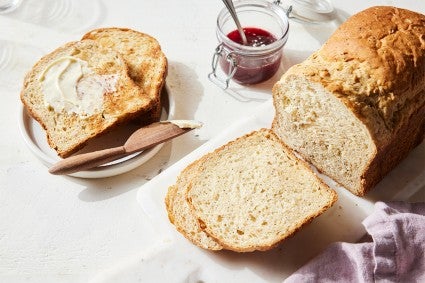
It would be great if the bread machine's chief product — sandwich loaves — would come out perfect every time. Beautifully risen, symmetrically domed, a lovely crust with no floury spots. But honestly? That's not the reality of bread machine baking. What you save in time and effort, you often lose in quality, including mishappen loaves or bread with those dreaded holes in the bottom from the bread machine's paddles.
But with just a minimal amount of effort, you can step in and help your bread machine as it kneads and shapes and bakes — thus ensuring yourself a higher percentage of perfect (or nearly so) loaves. You just need to be willing to touch the dough.
(Fair warning: If you're someone who likes to "set it and forget it" — add the ingredients, press Start, and come back 3 hours later — then this post isn't for you.)
Let's make some bread. We'll go with our most popular bread machine recipe: Bread Machine Bread — Easy As Can Be.
Begin by putting everything into the bucket of your bread machine. Putting the liquids in first makes the dough (and baked bread) less prone to floury spots.
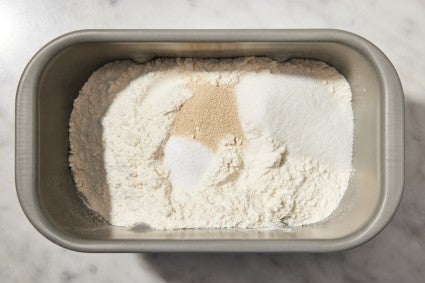
So many people seem afraid to "interfere" with their bread machine as it works. But honestly, nothing bad will happen if you open the lid and poke at the dough.
Start watching the dough about 10 minutes into its kneading cycle; it shouldn't be viscous and liquid-like, nor dry, stiff, and "gnarly." As fellow blogger Susan Reid says, "If you touch the dough and your finger comes back coated, the dough is too wet. If you touch the dough and it feels like poking a beach ball, it’s too dry."
The dough should have formed a cohesive unit and, if not "smooth as a baby's bottom" yet, should be headed in that direction. If it's not, add more flour (if it's too soft), or water (if it's dry).
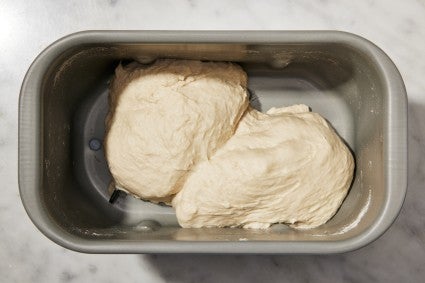

This step takes just a few seconds and will help prevent floury spots on the baked loaf's crust.
The timing for this can be a bit tricky; but once you figure it out, you're good to go forever.
Get out your kitchen timer, and put it in count-up (stopwatch) mode. Start your timer when you press "Start" on your bread machine (even if your machine has a "rest" or "preheat" mode right at the beginning); you're simply trying to gauge the amount of time between when you press start, and when the final rise begins.
You want to be around when your bread starts its final rise. Most bread machine manuals show a timeline of steps: e.g., preheat 31 minutes, knead 19 minutes, first rise 35 minutes, second rise 20 minutes, etc. A little simple arithmetic will give you an idea of when the final rise will start.
Hang around the kitchen when you figure that final rise is imminent. You'll hear the machine start up momentarily; it'll be knocking down the dough, which means the final rise is about to begin. When you hear that happen, stop your timer and check the time. (On our Zojirushi Virtuoso, it's 1 hour, 45 minutes).
So there you have it: You now know, for the next time you bake bread, that 1 hour, 45 minutes (or whatever) will elapse between the time you press "Start" and when the final rise begins. So whenever you make bread-machine bread and want to remove the paddles before the loaf bakes — pull out your timer and put it to good use.
Reach into the bucket, move the dough aside, and lift out the paddles.
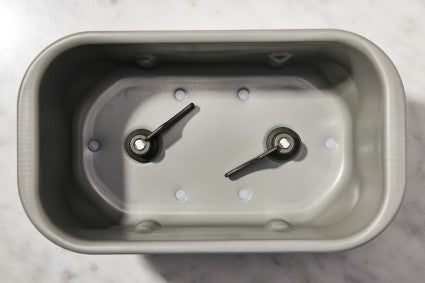
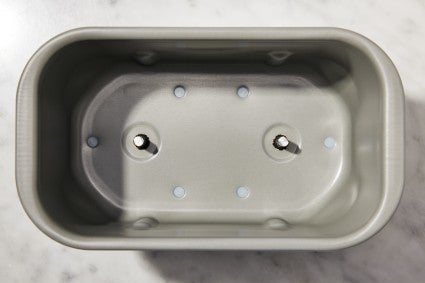
This step will result in loaves of bread without that noticeable divot at the bottom.
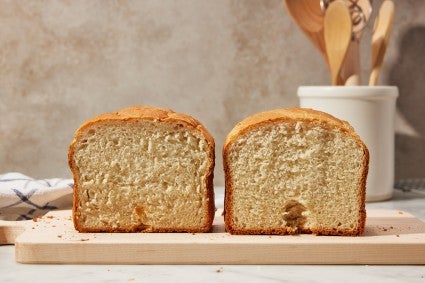
This is where you prevent ski-slope loaves — unevenly shaped bread that's much higher on one end than the other. When you open the lid of the machine to remove the bucket's paddles, check out the shape of the loaf. It might be just fine, filling the pan from end to end. Or it might look like this:
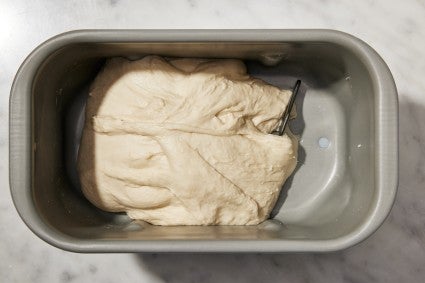
If the dough isn't in an acceptable loaf shape, take it out of the bucket, shape it into a nice, symmetrical log, and put it back into the bucket.
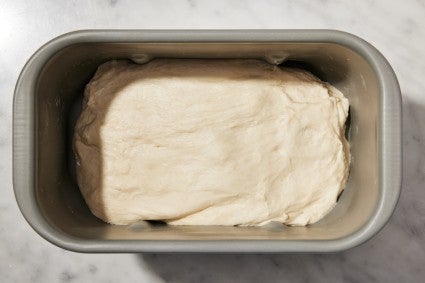
It will rise nice and evenly and bake into a lovely loaf.
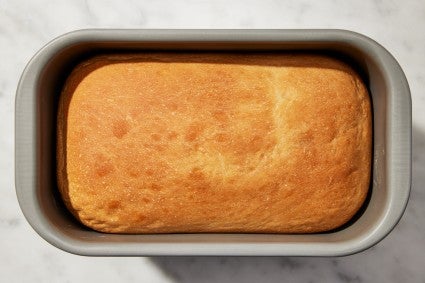
Isn't it annoying when you've done everything right, and your loaf still comes out looking ... well, not as good as it could?
You've pulled your gorgeous loaf out of the pan, and within minutes it develops a crust as wrinkled as Yoda. What's up with that? And how do you prevent it?
As soon as your bread is done, remove the bucket from the machine, take out the bread (which will be easy, since the paddles aren't there to impede its progress), and gently set the loaf back into the machine, sans bucket. Note: While setting the loaf back into the machine without its bucket is a reasonable option with our Zojirushi machines, it may not work well in other brands' machines. Let experience with your own machine be your guide here.
Crack the lid open an inch or so, and let the bread cool right in the turned-off machine. The still-warm (but gradually cooling) air helps prevent moisture from condensing on your loaf's surface — no wrinkles!
So, what's the baking science behind this? If your loaf hits the cooler air outside the machine, any moisture migrating from inside reaches the top surface and condenses, forming water droplets that cause the crust to shrink unevenly — in other words, to wrinkle.

Final step: Enjoy your wonderful homemade bread. Who says you can't bake a perfectly acceptable loaf right in your bread machine?
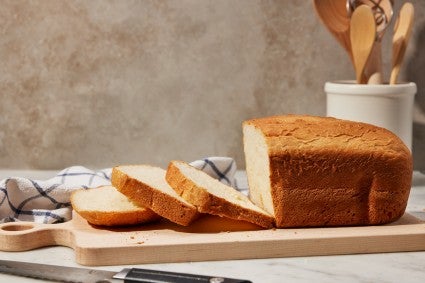
If you're looking for a great bread machine, our Zojirushi Home Bakery Virtuoso Plus Bread Machine has over 300 five-star reviews and is a beloved appliance for many King Arthur employee-owners.
Cover photo by Kristin Teig; food styling by Liz Neily.
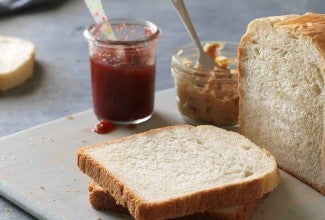


December 28, 2020 at 4:38pm
In reply to Hi, I've tried several bread… by Leigh Thomas (not verified)
We're sorry to hear that you're having trouble with your bread machine, Leigh! It sounds like the dough is becoming over-proofed, are you using the preheat setting along with warm ingredients? This could cause the dough to rise faster than the machine is expecting and cause the dough to be over-proofed and collapse while baking which can make for a dense loaf. We'd recommend using cooler ingredients next time around to see if this helps. Another reason the bread might be turning out dense is that a tad too much flour snuck its way into the mixing bowl — we recommend either using a kitchen scale to weigh your ingredients or using the fluff and sprinkle technique for measuring flour in volume. We hope this helps for future baking adventures!
November 23, 2020 at 5:06pm
Hello! I would like to make sourdough in my basic Zo (which I dropped and broke the other day; the new one will be here tomorrow). My question is about the 'hooch' (liquid on top of the starter), which I understand is what gives the bread its most sour taste. Should I mix that into my starter before measuring it for the recipe? Or can I use that in place of liquid? Thanks!
November 25, 2020 at 4:34pm
In reply to Hello! I would like to make… by Deborah Lancaster (not verified)
Hi there, Deborah! If it's a small amount of hooch, you can just stir it back in. If it's a larger amount and will change the consistency of your starter, we'd recommend pouring it off. Happy baking!
November 19, 2020 at 7:05pm
Hi there, I'm so glad I found this post on bread making tips! I can't wait to apply your insight to my next loaf attempt. I'm not seeing any reviews/comments from any Hamilton Beach bread machine owners. Do you know if this machine works well with your tips? Thank you for sharing your wealth with us!
November 23, 2020 at 4:42pm
In reply to Hi there, I'm so glad I… by Ashley (not verified)
Hi Ashley! We haven't tested these tips with a Hamilton Beach machine specifically, but we don't see why they wouldn't still work out!
November 29, 2020 at 5:28pm
In reply to Hi Ashley! We haven't tested… by mmoss
Thank you! I've tried this recipe a few times and am loving the results! I'm finding that the type of yeast you use is very important. Do you have you preferred yeast? Also, I'm having a hard time finding which post you mentioned how you can use the machine to knead and rise the loaf and then bake the bread in the oven instead of the bread machine. Can you share the link to that post? Thanks so much!!
December 1, 2020 at 2:43pm
In reply to Thank you! I've tried this… by Ashley (not verified)
Hi Ashley! We're so happy you are loving the results of this recipe. Our preference is SAF Instant Yeast for bread machines and recipes mixed by hand. There is reference towards the end of this blog, How to convert recipes to a bread machine, on using the bread machine to mix the dough, then finishing by hand. We hope this helps and happy baking!
November 14, 2020 at 10:14pm
What a great tip to remove the paddle!
My sourdough "fell" when I tried making it in the bread machine (tasted great, but not very pretty!).
I know my starter was good, as was my yeast.
It's possible the dough was a little wet, but I'm wondering if it overproofed? The machine I am using has a default "knock down"/"punch down" knead between rise 1 and rise 2. I omitted it, but should I have left this step in? If so, for how long?
November 17, 2020 at 12:54pm
In reply to What a great tip to remove… by Nicole T. (not verified)
We're sorry to hear that your bread didn't turn out as expected! We would recommend letting the machine deflate the dough between the first and second rise, this will help redistribute the yeast and make for a more even and successful rise. Alternatively, you can skip this with the machine and just deflate and shape the loaf when you take the dough out of the machine to remove the paddles. We hope this helps for future baking adventures!
October 27, 2020 at 9:43pm
Today I received my Zo Virtuoso Plus and my first loaf came out perfect! I can't wait to try more recipes. I'm wondering if you have a recipe for pasta dough. I'd love to make fresh pasta dough in my new favorite machine.
Pagination